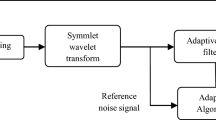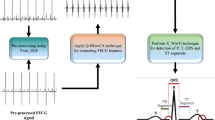Abstract
One of the most used traditional method to measure heart conductivity of fetal is the fetal Electrocardiography (FECG). Many indicators related to the health of fetal can be determined depending on FECG since fetal heart rate (FHR) is obtained from the components of FECG signal. Recording fetal ECG in a clinic forms a problem due to the interferences of other signals which corrupt the ECG signal. Another problem happen as a result to the location of the used electrodes for recording ECG since these electrodes are placed on the mother abdomen. The obtained abdominal ECG signal also contain different types of interferences. The maternal ECG represents the first big interference source with the FECG signal. Breathing, the activity of mother's muscle, electrode contact with the mother's skin, power line interference and thermal noise, all of them represent a possible noise source. In case of extraction ECG signal for twin gestation, clear FECG for every single fetal would be more difficult because in addition to the all mentioned source of interferences and noise, both fetuses may share the same morphology and FHR. Close monitoring to the heart of twin is required for early diagnose of congenial problems which infect heart. In this study a novel approach has been made by combining conventional Stone BSS and particle swarm optimization (PSO) to produce (MSBSS). The obtained results are compared with other two BSS algorithms (EFICA and JADE) in addition to the obtained results using conventional Stone BSS. MSBSS method has revealed better performance comparing with the other BSS techniques including original Stone BSS.


















Similar content being viewed by others
References
Rajesh, A. V., & Ganesan, R. (2014). Comprehensive study on fetal ECG extraction. In IEEE international conference on control, instrumentation, communication and computational technologies (ICCICCT).
Hornberger, L. K., & Sahn, D. J. (2007). Rhythm abnormalities of the fetus. Heart, 93, 1294–1300.
Roman, M. (2015). Text atlas of practical electrocardiography: A basic guide to ECG interpretation. Springer.
Lathauwer, L. D., Moor, B., & Vandewalle, J. (2000). Fetal electrocardiogram extraction by blind source subspace separation. IEEE Transactions on Biomedical Engineering, 47(5), 567–572.
Kaleem, A. M., & Kokate, R. D. (2019). Performance evaluation of fetal ECG extraction algorithms. Springer.
Kahankova, R., Martinek, R., & Bilik, P. (2016, November). Non-invasive fetal ECG extraction from maternal abdominal ECG using LMS and RLS adaptive algorithms. In International Afro-European conference for industrial advancement (pp. 258–271). Cham: Springer.
Fotiadou, E., Van Laar, J. O., Oei, S. G., & Vullings, R. (2018). Enhancement of low-quality fetal electrocardiogram based on time-sequenced adaptive filtering. Medical & Biological Engineering & Computing, 56(12), 2313–2323.
Agannath, D. J., & Selvakumar, A. I. (2014). Issues and research on foetal electrocardiogram signal elicitation. Biomedical Signal Processing and Control, 10, 224–244.
Kanjilal, P. P., Sarbani, P., & Goutam, S. (1997). Fetal ECG extraction using singular value decomposition. IEEE Transactions Biomedical Engineering, 44(1), 51–59.
Wang, Y., Fu, Y., & He, Z. (2018). Fetal electrocardiogram extraction based on fast ICA and wavelet denoising. In 2nd IEEE advanced information management, communicates, electronic and automation control conference (IMCEC 2018).
Akhavan-Amjadi, M. (2020). Fetal electrocardiogram modeling using hybrid evolutionary firefly algorithm and extreme learning machine. Multidimensional Systems and Signal Processing, 31(1), 117–133.
Al Dujaili, M. J., Ebrahimi-Moghadam, A., & Fatlawi, A. (2021). Speech emotion recognition based on SVM and KNN classifications fusion. International Journal of Electrical and Computer Engineering (IJECE), 11(2), 1259–1264.
Gaamouri, S., Salah, M. B., & Hamdi, R. (2018). Denoising ECG signals by using extended kalman filter to train multi-layer perceptron neural network. Automatic Control and Computer Sciences, 52(6), 528–538.
Xueyun, W., & Wei, Z. (2018). Application of kernel PCA for foetal ECG estimation. Electronics Letters, 54(6), 340–342.
Taylor, M. J., Smith, M. J., Thomas, M., Green, A. R., Cheng, F., Oseku-Afful, S., Wee, L. Y., Fisk, N. M., & Gardiner, H. M. (2003). Noninvasive fetal electrocardiography in singleton and multiple pregnancies. British Journal Obstetric Gynaecology, 110, 668–678.
Comani, S., Mantini, D., Alleva, G., Gabriele, E., Liberati, M., & Romani, G. L. (2005). Simultaneous monitoring of separate fetal magnetocardiographic signals in twin pregnancy. Physiological Measurement, 26, 193–201.
Keralapura, M., Pourfathi, M., & Sirkeci-Mergen, B. (2011). Impact of contrast functions in fast-ICA on twin ECG separation. IAENG International Journal of Computer Science, 38, 1.
Kotas, M., Leski, J. M., & Wrobel, J. (2016). Sequential separation of twin pregnancy electrocardiograms. Bulletin of the Polish Academy of Sciences. Technical Sciences, 64(1).
Salmanvandi, M., & Einalou, Z. (2017). Separation of twin fetal ECG from maternal ECG using empirical mode decomposition techniques. Biomedical Engineering: Applications, Basis and Communications, 29(6), 1750042.
Greville, W. J., & Buehner, M. J. (2016). Temporal predictability enhances judgements of causality in elemental causal induction from both observation and intervention. Quarterly Journal of Experimental Psychology, 69(4), 678–697.
Abdullah, A. K., & Zhu, Z. C. (2014). Enhancement of source separation based on efficient stone’s BSS algorithm. International Journal of Signal Processing, Image Processing and Pattern Recognition, 7(2), 431–442.
Stone, J. V. (2001). Blind source separation using temporal predictability. Neural Computation, 13, 1559–1574.
Khosravy, M., Asharif, M. R., & Yamashita, K. (2011). A theoretical discussion on the foundation of Stone’s blind source separation. Signal, Image and Video Processing, 5(3), 379–388.
Abdullah, A. K., & Zhu, Z. C. (2014). Enhancement of source separation based on efficient Stone’s BSS algorithm. International Journal of Signal Processing, Image Processing and Pattern Recognition, 7(2), 431–442.
Cichocki, A., Amari, S., Siwek, K., Tanaka, T., & Phan, A. H. (2004). ICALAB toolboxes. ICALAB i. http://www.bsp.brain.riken.jp.
De Moor, B., De Gersem, P., De Schutter, B., & Favoreel, W. (1997). DAISY: A database for identification of systems. JOURNAL A, 38, 4–5.
Author information
Authors and Affiliations
Corresponding author
Additional information
Publisher's Note
Springer Nature remains neutral with regard to jurisdictional claims in published maps and institutional affiliations.
Rights and permissions
About this article
Cite this article
Al-Dujaili, M.J., Mezeel, M.T. Novel Approach for Reinforcement the Extraction of ECG Signal for Twin Fetuses Based on Modified BSS. Wireless Pers Commun 119, 2431–2450 (2021). https://doi.org/10.1007/s11277-021-08337-y
Accepted:
Published:
Issue Date:
DOI: https://doi.org/10.1007/s11277-021-08337-y




